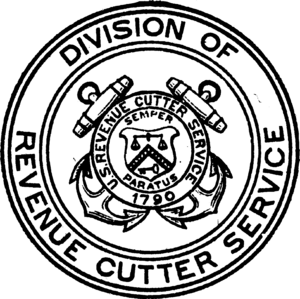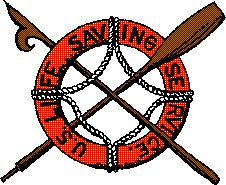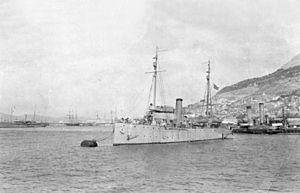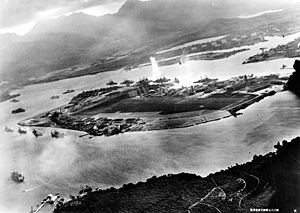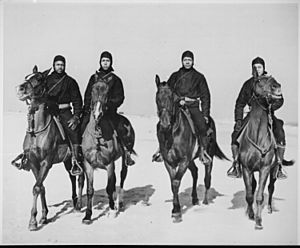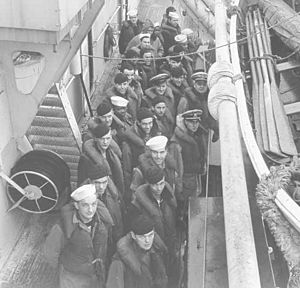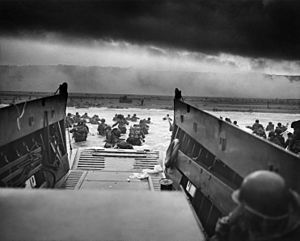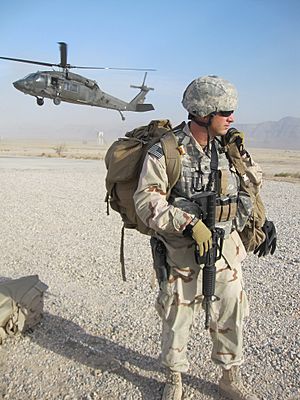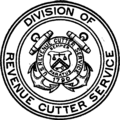History of the United States Coast Guard facts for kids
The history of the United States Coast Guard is a long and important one! It all started on August 4, 1790, with a group called the United States Revenue Cutter Service. This group was part of the government's money department, the Department of the Treasury. Later, in 1915, the Revenue Cutter Service joined with the United States Life-Saving Service to officially become the Coast Guard. This means the Coast Guard is a military service and part of the U.S. armed forces. In 1939, the United States Lighthouse Service, which managed lighthouses, also joined the Coast Guard.
Over the years, the Coast Guard moved to different government departments. In 1967, it became part of the Department of Transportation. Then, on March 1, 2003, it moved to the Department of Homeland Security. But remember, if there's a war or the President orders it, the Coast Guard can work with the U.S. Navy.
Contents
- Early Days of the Coast Guard
- World War I: Coast Guard Goes to War
- The 1920s: New Challenges
- The 1930s: Growing Responsibilities
- The 1940s: World War II and Beyond
- The 1950s: Korean War and Famous Rescues
- The 1960s: Changes and Vietnam War
- The 1970s: A New Era
- The 1980s: Disasters and Major Rescues
- The 1990s: Gulf War and Floods
- The 2000s: Homeland Security and Modern Conflicts
- The 2010s: New Challenges and Global Presence
- The 2020s: Looking Ahead
- Future of the Coast Guard
- Frank LoBiondo Coast Guard Authorization Act of 2018
- Coast Guard Museums
- Images for kids
Early Days of the Coast Guard
The Revenue-Marine: Protecting Early America
The Coast Guard we know today was officially formed in 1915. But its story goes way back to the very beginning of the United States! Alexander Hamilton, who was in charge of the Treasury, asked Congress to create a group of ships called "cutters." Their job was to collect taxes on goods coming into the country, which was a big way the new nation made money.
So, on August 4, 1790 (which is now the Coast Guard's official birthday!), Congress agreed. They built ten cutters and hired 40 officers. These ships were called the "Revenue-Marine." Each cutter worked on its own, patrolling a part of the East Coast and reporting to the local Customs House.
From 1790 to 1798, before the U.S. Navy was created, these revenue cutters were the only naval force the country had! They did many jobs:
- Stopping pirates.
- Rescuing sailors in trouble.
- Carrying government officials and mail.
- Stopping the illegal trade of enslaved people from Africa to the U.S. (between 1794 and 1865, they caught about 500 slave ships).
- Protecting government timber from people trying to steal it.
When there was a war, these cutters and their crews helped the Navy. They were involved in conflicts like the Quasi-War with France (1798-1799), the War of 1812, and the Mexican–American War.
The Revenue Cutter Service: Adventures and Heroes
The name "Revenue Cutter Service" became official in 1863, though people used it interchangeably with "Revenue-Marine" for a while. During the American Civil War, a Revenue Cutter Service ship named Harriet Lane fired the very first naval shots of the war! President Lincoln even ordered the revenue cutters to help the Navy fight.
After the U.S. bought Alaska in 1867, the Revenue Cutter Service played a huge role in exploring and developing the new territory. Captain Michael A. Healy, known as "Hell Roaring" Healy, helped bring reindeer to Alaska to provide food for the native Eskimo people.
In the winter of 1897-1898, three brave men from the Revenue Cutter Service and Public Health Service led an amazing journey. They drove a herd of reindeer 1,500 miles across Alaska to help starving whalers trapped by ice. For this heroic act, they received special medals from Congress!
During the Spanish–American War, a Revenue Cutter Service ship called USRC Hudson helped the U.S. Navy. It towed a damaged Navy ship out of danger during a battle. The crew of the Hudson received special medals for their bravery because, at that time, they weren't eligible for the Navy's highest award, the Medal of Honor.
The Lifesaving Service: Rescuing Those in Peril
Before the official Lifesaving Service, volunteer groups helped shipwrecked sailors along the coast. These groups had small boats and equipment stored in stations, ready for volunteers to use. In 1848, Congress started giving money to fund these lifesaving stations.
In 1871, Sumner Kimball took charge of the Revenue Marine Division, which oversaw these stations. He convinced Congress to provide more money for new stations and full-time crews. In 1878, the U.S. Lifesaving Service was officially organized, and Kimball became its leader.
Even though the Revenue Cutter Service is often seen as the main ancestor of the Coast Guard, the Lifesaving Service's spirit lives on strongly. The Coast Guard's famous search and rescue mission comes directly from it. The Coast Guard's unofficial motto, "You have to go out, but you don't have to come back," comes from the Lifesaving Service's rules from 1899. These rules basically said that rescuers must try every possible way to save people and should never give up until it's absolutely impossible.
Many Coast Guard traditions come from the Lifesaving Service. For example, members of the Lifesaving Service were called "surfmen." Today, the Surfman Badge is given to skilled boat operators who can handle motor lifeboats in big waves. The badge even looks like the old Lifesaving Service seal!
Coast Guard Academy: Training Future Leaders
The Coast Guard's training school started on July 31, 1876, in Massachusetts. It used a ship called USRC James C. Dobbin for training. The school moved a few times and eventually settled in New London, Connecticut.
In 1914, it became the Revenue Cutter Academy. When the Revenue Cutter Service and the Lifesaving Service merged in 1915, it became the United States Coast Guard Academy. New buildings for the academy were built in the 1930s, and cadets started using them in 1932.
The Modern Coast Guard is Born
On January 28, 1915, a special law by Congress officially merged the United States Revenue Cutter Service and the United States Lifesaving Service. This created the United States Coast Guard! On that day, the new Coast Guard had about 255 officers, 3,900 other personnel, a headquarters, 17 regional offices, an academy, 25 large ships, 20 smaller harbor ships, and 280 lifeboat stations.
World War I: Coast Guard Goes to War
Getting Ready for War
The Coast Guard started preparing for World War I even before the U.S. officially declared war on April 6, 1917. They improved telephone communications along the coast, connecting lighthouses and lifesaving stations. They also began training their first aviator, Third Lieutenant Elmer Stone, in 1916.
Germany had already started sinking ships, including American merchant ships, which led to the loss of American lives. The Coast Guard created a plan for how it would work with the U.S. Navy if war broke out.
When the U.S. declared war on April 6, 1917, the Coast Guard immediately became part of the Navy. All Coast Guard ships reported to the nearest Navy commander. The Coast Guard had fewer than 4,000 officers and men, 23 large ships, 21 smaller harbor ships, and 272 rescue stations.
The Navy used Coast Guard ships and experienced sailors to help with its rapid expansion. Coast Guard officers and petty officers (like sergeants in the Army) were often placed on Navy ships because of their great skills at sea. In 1918, twin sisters Genevieve and Lucille Baker became the first uniformed women to serve in the Coast Guard.
The Tragic Loss of USCGC Tampa
On September 26, 1918, a Coast Guard ship called USCGC Tampa was sailing alone after escorting a group of ships. A German submarine spotted her and fired a torpedo. The torpedo hit the Tampa, and she sank quickly. All 131 people on board were lost, including 111 Coast Guardsmen. This was the biggest loss of Coast Guard personnel in a single event during the war.
The 1920s: New Challenges
Enforcing Laws and Saving Lives
In the 1920s, the Coast Guard was given some former Navy destroyers to help enforce laws against illegal goods. This mission gave many Coast Guard officers and sailors valuable experience that would be very important in World War II.
During the terrible Great Mississippi Flood of 1927, the Coast Guard performed a massive rescue operation. They saved 43,853 people from dangerous situations and moved them to safety. They also saved over 11,000 animals and helped transport 72 people who needed hospital care. More than 670 Coast Guardsmen and 128 Coast Guard boats helped in these relief efforts.
The 1930s: Growing Responsibilities
Protecting Ships and Sailors
In 1932, two government groups that oversaw merchant ships and sailors joined together. Then, in 1934, a passenger ship called SS Morro Castle caught fire off New Jersey, and 124 people died. This tragedy led to new rules for fire safety on ships.
In 1942, the Coast Guard temporarily took over the duties of inspecting ships and making sure they followed navigation rules. This fit well with the Coast Guard's job of keeping ports safe, and it became a permanent responsibility in 1946.
Heroic Air Rescue
In January 1933, Lieutenant Commander Carl von Paulsen landed his seaplane, Arcturus, in rough seas off Cape Canaveral. He rescued a boy who was adrift in a small boat. The plane was so damaged it couldn't take off, but everyone, including the boy, was eventually saved when the plane washed ashore. Commander Paulsen received a Gold Lifesaving Medal for this brave rescue.
Lighthouses Join the Coast Guard
The United States Lighthouse Service, which was the oldest government agency (started in 1789), joined the Coast Guard on July 1, 1939. This meant the Coast Guard was now in charge of all lighthouses and other aids to navigation.
The 1940s: World War II and Beyond
World War II: Fighting for Freedom
Before the U.S. entered World War II, Coast Guard ships patrolled the North Atlantic. They helped set up a weather observation service using Coast Guard cutters.
When Germany invaded Denmark in 1940, President Roosevelt ordered the Coast Guard to continue its International Ice Patrol around Greenland. This was important because Greenland had valuable mines and helped with weather forecasts for Europe. The Coast Guard kept the Greenland Patrol going throughout the war.
The Coast Guard was directly involved in the first World War II attack on America at Pearl Harbor in 1941. Coast Guard cutters, patrol boats, and personnel helped U.S. naval forces, fighting off Japanese aircraft. The USCGC Taney, a famous Coast Guard ship, was at Pearl Harbor and is still afloat today as a museum ship!
During the war, there was a lot of worry about enemy ships near U.S. shores. Coast Guardsmen patrolled beaches to look for suspicious vessels, prevent enemy landings, and stop communication between people on shore and the enemy at sea. On June 13, 1942, Seaman John Cullen, patrolling a beach in New York, discovered German spies who had landed. His report led to their capture, and he received a special award for it.
Coast Guard ships were very active in the war:
- The USCGC Modoc was involved in the chase and sinking of the German battleship Bismarck.
- After Germany started sinking ships off the American coast, Coast Guard ships like USCGC Icarus and USCGC Thetis sank German submarines. The Icarus even captured 33 German prisoners, the first Germans taken in combat by any U.S. force!
- The USCGC Campbell rammed and sank a German submarine, and its enlisted mascot, Sinbad, became a public hero.
- The Coast Guard sank 12 German and two Japanese submarines during the war.
Many Coast Guard ships were used for escorting groups of merchant ships across the Atlantic, protecting them from submarines. Coast Guardsmen also worked closely with the Navy and Marine Corps. Many Coast Guardsmen operated Higgins boats, which were landing craft used in amphibious invasions like those in North Africa and Sicily.
In November 1942, the Coast Guard Women's Reserve, called the SPARS, was created. About 11,000 women served in various jobs in the U.S., freeing up men for overseas duty.
On February 3, 1943, after a transport ship was torpedoed off Greenland, Coast Guard cutters Comanche and Escanaba responded. The water was freezing, giving survivors only minutes to live. The crew of the Escanaba used a new rescue technique, sending swimmers in wetsuits to victims to attach lines. The Escanaba saved 133 men, and the Comanche saved 97. Sadly, the Escanaba was lost a few months later with most of her crew.
During the Normandy invasion on June 6, 1944, a group of 60 Coast Guard cutters, nicknamed the "Matchbox Fleet," helped with combat search and rescue, saving 400 Allied airmen and sailors. Coast Guard-crewed landing craft were also used to land troops on the beaches.
On January 29, 1945, a Coast Guard-crewed ship, USS Serpens, exploded off Guadalcanal while loading depth charges. This terrible explosion killed 193 Coast Guardsmen and many others, making it the biggest single disaster for the Coast Guard during the war.
Douglas Munro: A True Hero
Signalman First Class Douglas Munro (1919-1942) is the only Coast Guardsman to receive the Medal of Honor, the highest military award. He earned it after he bravely helped evacuate U.S. Marines under heavy fire during the Battle of Guadalcanal in 1942. Two Coast Guard ships have been named in his honor.
The Bermuda Sky Queen Rescue
On October 14, 1947, a large flying boat called Bermuda Sky Queen was flying across the Atlantic with 69 passengers. Strong winds slowed it down, and it started running low on fuel. The captain decided to land the plane near the USCGC Bibb (WPG-31), a Coast Guard cutter on duty in the North Atlantic.
In 30-foot waves, transferring the passengers was very difficult and dangerous. The Coast Guard crew used a rubber raft and a small boat to get people from the plane to the cutter. After rescuing 47 passengers, the weather got worse, and they had to stop. But by dawn, the weather improved, and the remaining passengers and crew were safely transferred to the Bibb. This amazing rescue, where all 69 people were saved, made headlines across the country!
Training New Recruits
In 1948, a training center for new Coast Guard recruits was set up in Cape May, New Jersey. By 1982, all Coast Guard recruit training was done at this one facility.
The 1950s: Korean War and Famous Rescues
Korean War: Supporting the Effort
During the Korean War, Coast Guard officers helped with the evacuation of the Korean Peninsula. In 1950, a new law made the Coast Guard responsible for keeping U.S. ports and harbors secure all the time. The Coast Guard also set up weather ships in the North Pacific and helped civilian and military aircraft and ships in trouble. They also built special navigation stations in Japan and Korea to help United Nations forces.
The Incredible Pendleton Rescue
On February 18, 1952, during a terrible winter storm off New England, two oil tankers, the SS Fort Mercer and the SS Pendleton, broke in half! The Pendleton couldn't even send a distress call.
Boatswain's Mate First Class Bernard C. Webber, who was in charge of Coast Guard Motor Lifeboat CG 36500 from Chatham, Massachusetts, led an incredible rescue. With amazing skill, he steered his 36-foot lifeboat under the stern (back) section of the broken Pendleton. The tanker's crew, trapped inside, climbed down a rope ladder and jumped into the water, where Webber and his crew pulled them into the lifeboat one by one. Webber and his three crew members all received the Gold Lifesaving Medal for their heroic actions.
In total, the Coast Guard rescued 62 people from the two broken ships. This rescue is so famous that the first of the Coast Guard's new patrol boats, USCGC Bernard C. Webber, was named in his honor. The story was even made into a movie called The Finest Hours.
The 1960s: Changes and Vietnam War
Moving to a New Department
On April 1, 1967, the Coast Guard moved from the Department of the Treasury to the newly created Department of Transportation.
The "Racing Stripe" Design
In 1967, the Coast Guard adopted its famous red and blue "racing stripe" design for its ships, boats, and aircraft. This design was suggested by a design firm to give Coast Guard units a unique look and make them easier to recognize from a distance. Other coast guards around the world, like the Canadian Coast Guard, later adopted similar designs.
Vietnam War: Supporting Operations Overseas
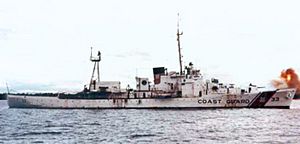
The Coast Guard was very active in the Vietnam War, starting in May 1965. Coast Guard ships helped with "Operation Market Time," which aimed to stop supplies from reaching enemy forces by sea. They also provided gunfire support for operations on shore.
Many Coast Guard ships, including 82-foot patrol boats, were sent to Vietnam with their Coast Guard crews to work under the U.S. Navy. Coast Guard aviators (pilots) also served with the U.S. Air Force in combat search and rescue missions.
The Coast Guard also helped the U.S. Army in Vietnam by supervising the unloading of explosives and ammunition from ships. They also helped with port security.
In 1965, the Coast Guard helped build a chain of special navigation stations in Thailand and Vietnam to help naval vessels and aircraft. They also helped maintain navigation aids like buoys in Vietnamese waters, and trained South Vietnamese crews to take over these duties.
The Coast Guard's involvement in the Vietnam War ended in April 1975. Seven Coast Guardsmen were killed during the war.
The 1970s: A New Era
The "New Guard" and Women in Service
In the mid-1970s, the Coast Guard changed its uniforms to the blue ones seen today. This was part of a shift to an all-volunteer force after the Vietnam War.
A big change happened in 1973 when women were fully integrated into the active-duty Coast Guard and the Coast Guard Reserve. This meant women could serve in many more roles, and by 1978, all job types were open to women. The Coast Guard was ahead of other military branches in this integration.
End of Ocean Stations, New Fishing Patrols
One major Coast Guard mission, maintaining Ocean Stations (ships that acted as floating lighthouses) came to an end. This was because airplanes improved, and new navigation technology made these stations less necessary.
However, a new law in 1976 increased the need for offshore fishing patrols. The Coast Guard's newer, larger ships were used for this, as older World War II-era ships were retired.
The Kudirka Incident
On November 23, 1970, a Soviet sailor named Simonas "Simas" Kudirka jumped from his Soviet ship onto a U.S. Coast Guard cutter, the USCGC Vigilant (WMEC-617) (USCGC Vigilant), near Massachusetts. He was seeking freedom.
After some confusion and communication problems, a U.S. Coast Guard admiral ordered that Kudirka be returned to the Soviet ship. This decision caused a lot of controversy and led to changes in how the U.S. Coast Guard handled requests for asylum. Kudirka was later found to have a claim to American citizenship and was allowed to come to the U.S. in 1974. This incident was even made into a TV movie.
The Rescue of AF586
On October 26, 1978, a Navy P-3C aircraft with 15 crew members had to ditch (land in the water) in the North Pacific Ocean after an engine fire. The Coast Guard HC-130H aircraft, CGNR 1500, played a crucial role in saving lives.
Arriving after dark in stormy weather, the Coast Guard plane marked the survivors' rafts and then guided a Soviet fishing vessel to them. The fishing vessel rescued ten survivors and recovered three crew members who had died from exposure. Without the Coast Guard's help, it's unlikely the other ten crew members would have survived much longer in the freezing water.
The 1980s: Disasters and Major Rescues
The Blackthorn Tragedy
On January 28, 1980, the Coast Guard buoy tender USCGC Blackthorn (WLB-391) collided with a large oil tanker, the SS Capricorn. The Blackthorn capsized (flipped over), and 23 Coast Guardsmen drowned. This was a very sad event for the close-knit Coast Guard.
The Prinsendam Rescue
On October 4, 1980, the Coast Guard and the Canadian Coast Guard worked together to rescue all passengers and crew from the Dutch cruise ship MS Prinsendam in the Gulf of Alaska. A fire broke out on the ship, and the captain ordered everyone to abandon ship into lifeboats.
Coast Guard and Canadian helicopters, along with several cutters, responded. Despite the ship being far from land and the difficult conditions, all 520 passengers and crew were rescued without any serious injuries or loss of life. This rescue was a huge success because of the long distances involved and the great teamwork between different organizations.
The Marine Electric Sinking
On February 12, 1983, the cargo ship SS Marine Electric sank in a storm off Virginia. Most of the crew were lost. As a result, the Coast Guard completely reviewed its rescue procedures, ship inspection methods, and safety equipment requirements for ships.
Important changes came from this disaster:
- Better inspection of ship deck covers.
- All ships now had to provide special equipment for survival in cold water for every crew member.
- The creation of the Coast Guard rescue swimmer program in 1984, greatly improving rescue training.
The Mariel Boatlift
In April 1980, the government of Cuba allowed people who wanted to leave to gather in Mariel Harbor and find their own way out. Many people tried to sail to Florida in homemade boats. The U.S. Coast Guard, working out of Miami, rescued many boats in trouble, checked vessels for safety, and helped process the refugees. This was a huge and difficult task, especially when a hurricane hit, sinking many boats. The Coast Guard rescued and processed 125,000 refugees between April and May 1980.
The End of Lightships
Over the 20th century, the number of lightships (ships that acted as floating lighthouses) slowly decreased. They were replaced by fixed structures or buoys. The last U.S. lightships were replaced by large buoys in 1979 and 1983. Technology for all aids to navigation improved dramatically, making them easier to maintain and requiring fewer people.
Libyan Attack on LORAN Station Lampedusa
On April 15, 1986, Libya fired missiles at a U.S. Coast Guard navigation station on the Italian island of Lampedusa. The missiles landed in the sea and caused no damage. After this attack, the Coast Guard station became a NATO base with better security.
The Exxon Valdez Oil Spill
In March 1989, the oil tanker Exxon Valdez hit a reef in Alaska and spilled a huge amount of crude oil. Because this happened in navigation waters, the Coast Guard was in charge of the cleanup effort.
Coast Guard cutters were among the first to respond, quickly setting up a safety zone around the damaged ship. They oversaw the use of booms and skimmers to contain and clean up the oil. Coast Guard planes also flew over the spill to track its movement and gather important information for the cleanup plan.
The 1990s: Gulf War and Floods
Operation Desert Shield and Desert Storm
In August 1990, the Coast Guard sent special Law Enforcement Detachments (LEDETs) to the Persian Gulf to help enforce United Nations rules against Iraq. These teams helped board and inspect ships. About 60% of all ship boardings by U.S. forces were led or supported by Coast Guard LEDETs.
President George H. W. Bush also called up Coast Guard reservists to active duty. Three Port Security Units (PSUs), made up of 550 reservists, were sent to the Persian Gulf. This was the first time Coast Guard Reserve PSUs were sent overseas against their will.
During the war, Coast Guard LEDET personnel helped when a Navy ship cleared Iraqi oil platforms and took prisoners. A Coast Guard Port Security Unit boat was the first to enter the newly reopened harbor in Kuwait City after the war.
The Coast Guard also helped with environmental protection during the war. When Saddam Hussein's army tried to pollute the Persian Gulf by pouring oil into it, Coast Guard planes flew over the giant oil slick to monitor it and help plan the cleanup.
Operation Buckshot: The Great Flood of '93
In 1993, the Mississippi, Missouri, and Illinois River basins experienced "500-year" flooding. This massive flood closed over 1,250 miles of river and caused 47 deaths. Thousands of people were forced from their homes.
The Coast Guard in St. Louis activated a plan to deal with many requests for help from state and local governments. They provided law enforcement, helped with sandbagging, performed water rescues, evacuated flood victims, and used aircraft to survey levee conditions. Coast Guard personnel also helped transport food, water, and sandbags, and assisted Red Cross and Salvation Army workers. They even rescued many homeless animals!
Special Disaster Response Units (DRUs) were formed from active duty and reserve units. Coast Guard helicopters and Auxiliary aircraft provided search and rescue, logistical support, and aerial intelligence. Many Coast Guardsmen, reservists, and Auxiliary members were involved in this huge operation.
1994 Cuban Boat Rescues
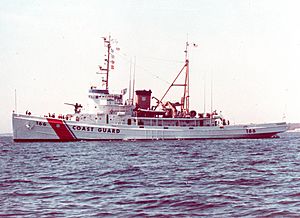
In 1994, about 38,000 Cubans tried to sail from Cuba to Florida, many on homemade rafts. The Coast Guard and Navy carried out huge search and rescue efforts to save these rafters at sea. Sixteen 110-foot cutters, half of the Coast Guard's fleet, were involved. Because of a change in U.S. policy, rescued Cubans were sent to the U.S. Naval Station at Guantanamo Bay, Cuba.
1999 Kosovo: Supporting Peacekeeping
In the summer of 1999, the USCGC Bear (WMEC-901) deployed to the Adriatic Sea to support military operations in Kosovo. The Bear provided surface surveillance, search and rescue, and protection for U.S. Army vessels carrying military cargo between Italy and Albania. The Bear earned special medals for its service in Kosovo.
The 2000s: Homeland Security and Modern Conflicts
Joining the Department of Homeland Security
On March 1, 2003, the Coast Guard moved from the Department of Transportation to the new Department of Homeland Security. This change happened under the Homeland Security Act.
In 2002, the Coast Guard sent several 110-foot cutters to the Persian Gulf to enforce United Nations rules on goods going to and from Iraq. Port Security Units and other specialized teams also supported the U.S. military buildup.
Wars in Iraq and Afghanistan
During Operation Iraqi Freedom and Operation Enduring Freedom, the Coast Guard sent its largest group of personnel and ships overseas since the Vietnam War. Coast Guard cutters helped protect forces and search for and seize suspected smugglers in Iraqi and international waters.
Coast Guard military trainers also helped improve the skills of the Iraqi Navy and other government forces in maritime law enforcement. Coast Guard advisors helped Iraqi officials meet international port security standards. The USCGC Walnut (WLB-205) even helped fix and replace navigation aids on the Khor Abd Allah River, making it safe for military, humanitarian, and commercial ships to use.
The Coast Guard sent special Redeployment Assistance and Inspection Detachment (RAID) teams to both Iraq and Afghanistan. These teams helped other military units properly prepare and inspect shipping containers to ensure they were safe for transport. The Coast Guard also provided intelligence and cyber experts in Afghanistan.
Sadly, on April 24, 2004, Petty Officer 3rd Class Nathan B. Bruckenthal, 24, became the first Coast Guardsman to die in a combat zone since the Vietnam War. He was killed during a boat attack on an oil terminal off the coast of Iraq while performing his security mission.
At its busiest during these wars, the Coast Guard had over 1,200 men and women deployed, including reservists, 11 ships, 4 port-security units, and other teams. They performed many different operations in Iraq, Afghanistan, Kuwait, and the Persian Gulf. Even after the official end of these operations, Coast Guard units continue to deploy to the Middle East to provide harbor defense and security.
Hurricane Katrina: A Massive Rescue Effort
After Hurricane Katrina hit in August 2005, the Coast Guard quickly sent many helicopters, planes, small boats, and 25 cutters to the Gulf Coast. They rescued 2,000 people in just two days and about 33,500 people in total! Crews also checked for damage to offshore oil platforms and refineries.
More than 2,400 Coast Guard personnel from all over the country helped with search, rescue, and recovery operations. They also helped with the joint effort to evacuate over 9,400 patients and medical staff from hospitals in the Gulf Coast region.
In May 2006, President George W. Bush awarded the entire Coast Guard, including the Coast Guard Auxiliary (volunteers), the Presidential Unit Citation for their incredible efforts after Hurricane Katrina.
HC-130 #1705 Crash
On October 29, 2009, a Coast Guard HC-130 aircraft with seven crew members collided with a United States Marine Corps (USMC) helicopter with two crew members off San Clemente Island. Both aircraft crashed into the ocean, and all nine crew members are believed to have died. The C-130 was searching for a missing boater.
The 2010s: New Challenges and Global Presence
Deepwater Horizon Oil Spill
The Coast Guard played a major role in the response to the Deepwater Horizon oil spill in 2010.
CG-6535 Crash
On February 28, 2012, a U.S. Coast Guard MH-65C Dolphin helicopter with four crew members crashed into Mobile Bay, Alabama, during a training mission.
Icebreakers: Protecting Polar Regions
By 2015, the United States only had one medium and one heavy icebreaker, down from a fleet of eight. The Coast Guard believes it needs three heavy and three medium icebreakers to do its job properly in the polar regions. Many other countries, like Russia, Canada, and Finland, have more icebreakers than the U.S. Because of this, there have been calls to fund new icebreakers for the Coast Guard.
In January 2016, a Coast Guard patrol boat, USCGC Monomoy, received one of the first reports about ten U.S. Navy sailors who had been detained by Iranian naval forces. A Navy petty officer activated a radio beacon while at gunpoint, and the signal was received by the Monomoy. This information helped in the search and rescue operation, and the cutter eventually escorted the sailors to safety after they were released.
The 2020s: Looking Ahead
The U.S. Coast Guard plans to base some of its cutters in Taiwan. This is a response to Chinese maritime activities that are seen as a threat to Taiwan.
Future of the Coast Guard
The Integrated Deepwater System Program is a plan to prepare the Coast Guard for future threats to the U.S. from the sea. This program includes getting new ships and aircraft, as well as upgrading technology for communication, intelligence, and surveillance.
A key part of this plan is the Maritime Security Cutter, Large (WMSL), which will replace the current large cutters. These new ships will be 421 feet long, very powerful, and able to travel long distances for up to 60 days. The first ship in this class, the USCGC Bertholf, was delivered in 2008.
Another important vessel is the Maritime Security Cutter, Medium (WMSM), which will be 341 feet long and able to patrol for 45 days. Both the WMSL and WMSM cutters will be able to carry two helicopters or four unmanned aerial vehicles (drones).
There have been some challenges with the Deepwater program, including high costs. Some people have questioned whether the Coast Guard should invest in more, simpler vessels instead of very expensive, high-tech ones.
Frank LoBiondo Coast Guard Authorization Act of 2018
In December 2018, President Donald Trump signed a law called the Franklin LoBiando Coast Guard Authorization Act of 2018. This law approved a budget of $7.9 billion for the Coast Guard's operating expenses. It also authorized more money for improving its buildings and equipment. The law allowed for 43,000 active duty employees in 2018 and 44,500 for the following year.
Coast Guard Museums
- Coast Guard Museum Northwest
- Virginia Beach Surf & Rescue Museum
- Coast Guard Heritage Museum
Images for kids


